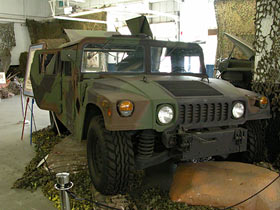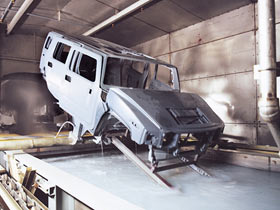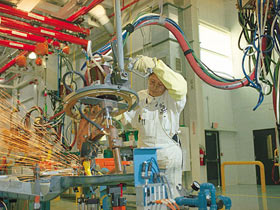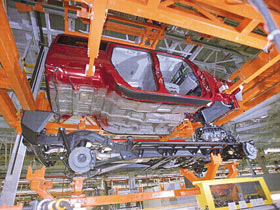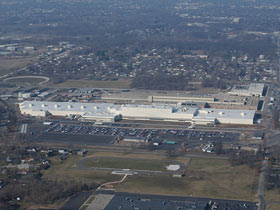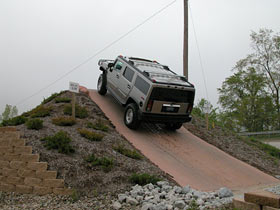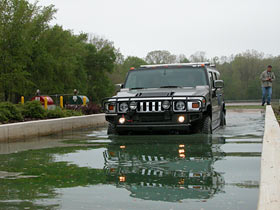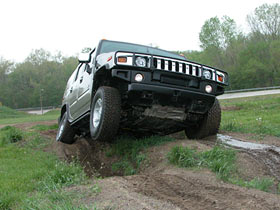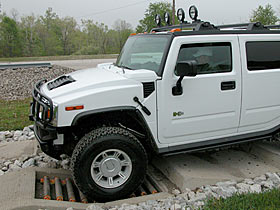|
|
||||||||||
|
But what about those who want to really test their H2's abilities and find out what it can really do? Many of them have never been off-road and don't even know where to start. Where can they turn to learn the basics? The Hummer Driving Academy is where. For $3,757 (pricing when we attended), Hummer H2 owners can attend the 3-day-long academy. A 5-day H1 Academy is also held for H1 owners at a higher cost. In order to attend the academies, you must be a Hummer owner. Getting to South Bend is up to you, but once you get off the plane, everything is taken care of, including ground transportation, a wonderful room at the Marriott, all of your meals, use of an H2 (of course), and tons of goodies throughout the visit. Located in South Bend, Indiana, the academy takes place at the AM General Test Track. The facility encompasses 320 acres of land owned by AM General on the very same trails used to design and test the first Hummer HMMWV (Humvee) in the early 80's. After my visit, I was picked up and whisked back to my hotel room where I frantically got ready for the welcome reception. Food and brews were in abundance as the group of attendees got to meet the Hummer staff and get to know to each other. There couldn't have been a better way to start off the evening than this. We spent a couple hours learning about each others' off-road experience (or lack of), what everyone did for a living, and how they were enjoying their new H2s. We talked, laughed, and carried on until the hotel staff had to practically have us removed so they could clean up and go home for the night. Morning came around quickly and we all met for breakfast in the beautiful hotel atrium. Afterward, we all loaded up in the van (Chevrolet, of course, since H2s are built under GM's wings) and took a ride out to the H2 plant. For me, this was one of the highlights of the trip. We were instructed to leave our cameras in the van and go upstairs to the meeting room, where we were outfitted with wireless radio receivers so we could hear our guides in the plant and were issued jewelry and watch covers. Everything must be covered before going into the plant. The H2 plant is a state-of-the-art plant and is operated much like any other GM plant - and very unlike the H1 facility. Larry Day, Program Manager for Operations, gave us an overview of the plant, complete with slide show and we then split into two groups for the plant tour. In order to build the H2 plant next door to the H1 plant, Hummer had to purchase 51 homes. Built in just sixteen months, the $245million facility and parking lot now sit where those home sites were. In fact, the former Bolson Street is now the main walk-way through the plant.
We got to watch the RoDip-3 in action and it was simply amazing to watch, as it rolls a complete H2 body assembly through an acid bath prior to moving it to through the painting process. Though 24 robots are in use throughout the plant (22 do welds), 60% of the welds are still done by hand. UAW #5 is the oldest auto workers union still around and is the same union that produced Studebakers. The workers operate in teams, cranking out around 86 H2s per shift. The total body tolerance goal for an H2 is to be less than 2mm. Currently, however, the average is more like 3.5mm, which is not world class, but is acceptable. Hummer's goal, of course, is to move H2 closer and closer the goal. Each day in a specially-constructed floating room designed to isolate the H2 from vibrations, robots check tolerances of every seam on an H2. In addition, an H2 is systematically pulled apart, weld by weld to check quality. By studying the tolerances and welds, Hummer hopes to reach their quality goals. Walking through nearly every aisle in the H2 plant was simply amazing. Watching the workers hand-assemble so much of the truck reminded us that there really is still a human side to the auto-building process. A few of us could have happily spent the whole day milling around the plant, but it was time for the real academy activities to begin, so we saddled back up in the van and headed out to the test track. Tim Bonadies was at the track to welcome us and give us an overview of what the academy had in store for us. He wasted no time and immediately began our classroom training. Knowing that we were all eager to climb into the H2s parked outside, he wasted no time and we were headed for the controlled obstacle portion of our training. The gang at the test track constructed a specially-built obstacle course to show the H2 owners the outer limits of what their trucks can do in a safe and controlled atmosphere. The course included steps, moguls, off-camber sections, rocks and mud, metal roller sections to show 4WD system operation, and a water-fording area. The obstacle course was really an amazing tool to show what the trucks can do. Perhaps the most impressive part of the course was the off-camber section. The 22-degree side-grade would have easily toppled just about every truck or SUV on the market, but the H2 held its ground beautifully. It made some drivers understandably nervous, but once they got through it, they came out with a new confidence in their trucks. The entire course really made the drivers feel comfortable in situations they had likely never been in. The majority of our group had never even been off-road - let alone driven over steps, through moguls on three wheels, or through water. Watching their faces as they traversed the obstacles unscathed and finishing on all four wheels was a lot of fun for me and the trainers. The course has proved to be such a great learning tool that Hummer now offers building plans to its dealerships for them to build courses of their own.
|
||||||||||
|
Help spread the ROCKCRAWLER world!
Share on Facebook
|


